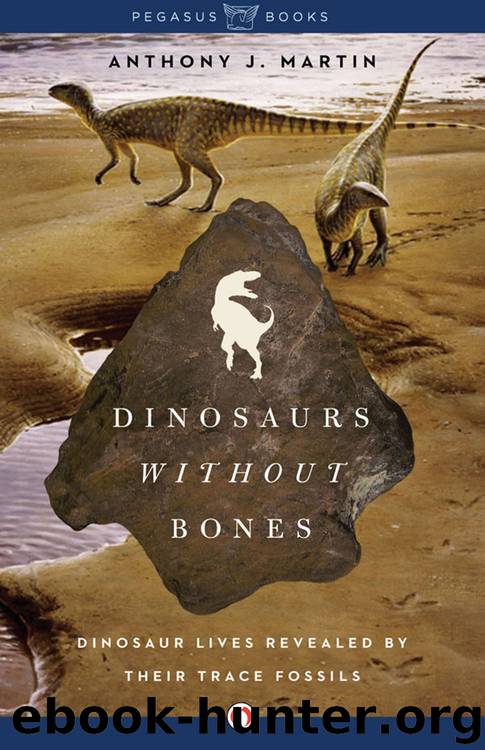Dinosaurs Without Bones by Anthony J. Martin

Author:Anthony J. Martin [Martin, Anthony J.]
Language: eng
Format: epub, azw3
ISBN: 978-1-4804-4802-5
Publisher: Pegasus Books
Published: 2014-01-24T21:55:00+00:00
Was it from rocks of the same age as dinosaurs (Late Triassic through Late Cretaceous)?
Did it come from rocks formed in a continental environment, such as a former soil, river, or lake?
Were other dinosaur body and trace fossils in the same rocks?
Does it fall in the right size range for known dinosaur coprolites?
Does it contain any body fossils of what might have been digested, such as plant or bone fragments?
Only when you have answered this checklist with “yes” for every item should you take your rock to a professional scientist. Otherwise, she will tell you wearily that wrongly identified “coprolites” are the bane of her existence, rivaled only by wrongly identified “meteorites” and “gold.” In this respect, the most basic questions—dealing with age, environment, co-occurrence with other dinosaur fossils—are very important. For instance, if you found this rock in Cincinnati, Ohio, I would instantly tell you it is not a dinosaur coprolite. Cincinnati’s a great city with a lot going for it, but it has the wrong age rocks (Ordovician Period, 450 million years old) and wrong rocks (shallow marine limestones and shales), and hence no dinosaur fossils. As a result, its civic boosters should never add “dinosaur coprolites” to its list of local natural wonders, which would remain true even if you crossed the Ohio River and went into Kentucky.
Of these criteria, by far the most important one is that it contains body fossils of whatever the dinosaur ate. A suspected coprolite may look like fossil crap, feel like fossil crap, and taste like fossil crap, but does not qualify as fossil crap unless it holds fossil food. There had better be plant tissues, spores, seeds or pollen, bits of bone, insect or crustacean parts, or other bodily remains for a lumpy chunk of rock to qualify as a genuine, bona-fide coprolite.
The least important criterion applied to coprolites is size, and that is because of its variability. Dinosaur dung may have been as big as footballs (American or Australian rules), or it could have been as small as chocolate-covered raisins. Coprolite size would have depended on: the age and size of the defecating dinosaur; its health; time of the year; or what happened to the dung after it emerged. Even the mere act of dinosaur-cloacal pinching would have affected the size of each exiting nugget, meaning the total volume of feces might have been quite high but composed of many pieces snipped by a well-honed sphincter. Of course, falling and landing on the ground would have altered the size and shape of such deposits depending on mass, anal altitude, and relative solidity. Some feces would have gone “thud” and flattened slightly on impact. Others would have gone “splat” and spread out over a sizeable area. Those left by swimming dinosaurs might have been floaters, making no sound at all. Smell would have entered this equation, too, as dung-loving insects or other animals in the area would have picked up on any distinctive odors and hurried to indulge.
Nonetheless, by far
Download
This site does not store any files on its server. We only index and link to content provided by other sites. Please contact the content providers to delete copyright contents if any and email us, we'll remove relevant links or contents immediately.
| Amphibians | Animal Behavior & Communication |
| Animal Psychology | Ichthyology |
| Invertebrates | Mammals |
| Ornithology | Primatology |
| Reptiles |
Sapiens: A Brief History of Humankind by Yuval Noah Harari(14322)
The Tidewater Tales by John Barth(12627)
Mastermind: How to Think Like Sherlock Holmes by Maria Konnikova(7281)
Do No Harm Stories of Life, Death and Brain Surgery by Henry Marsh(6908)
The Thirst by Nesbo Jo(6882)
Why We Sleep: Unlocking the Power of Sleep and Dreams by Matthew Walker(6659)
Life 3.0: Being Human in the Age of Artificial Intelligence by Tegmark Max(5519)
Sapiens by Yuval Noah Harari(5325)
The Longevity Diet by Valter Longo(5044)
The Body: A Guide for Occupants by Bill Bryson(5033)
The Rules Do Not Apply by Ariel Levy(4912)
The Immortal Life of Henrietta Lacks by Rebecca Skloot(4552)
Animal Frequency by Melissa Alvarez(4430)
Why We Sleep by Matthew Walker(4395)
The Hacking of the American Mind by Robert H. Lustig(4342)
Yoga Anatomy by Kaminoff Leslie(4335)
All Creatures Great and Small by James Herriot(4277)
Double Down (Diary of a Wimpy Kid Book 11) by Jeff Kinney(4244)
Embedded Programming with Modern C++ Cookbook by Igor Viarheichyk(4144)
